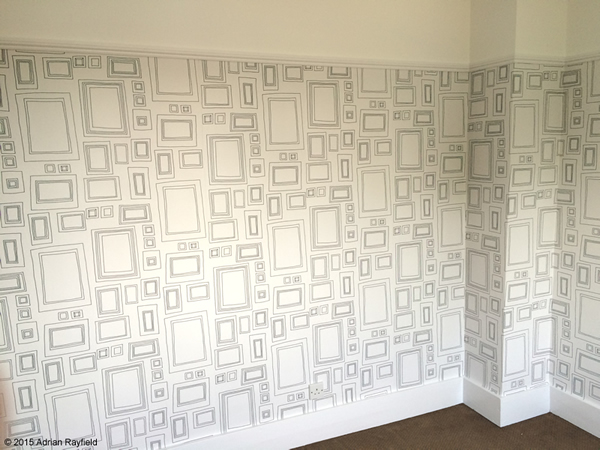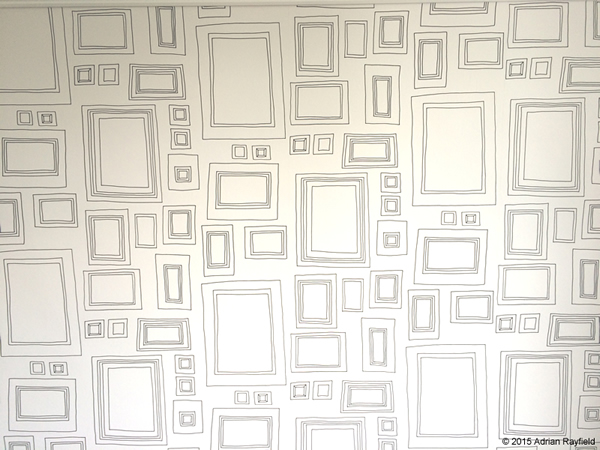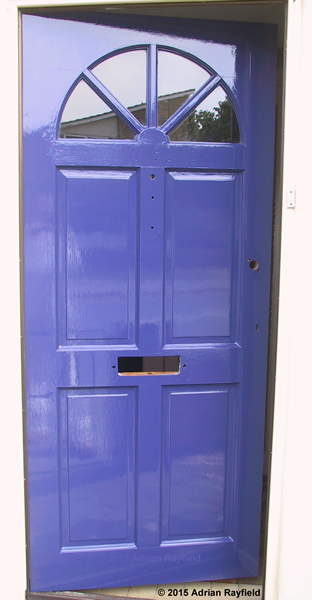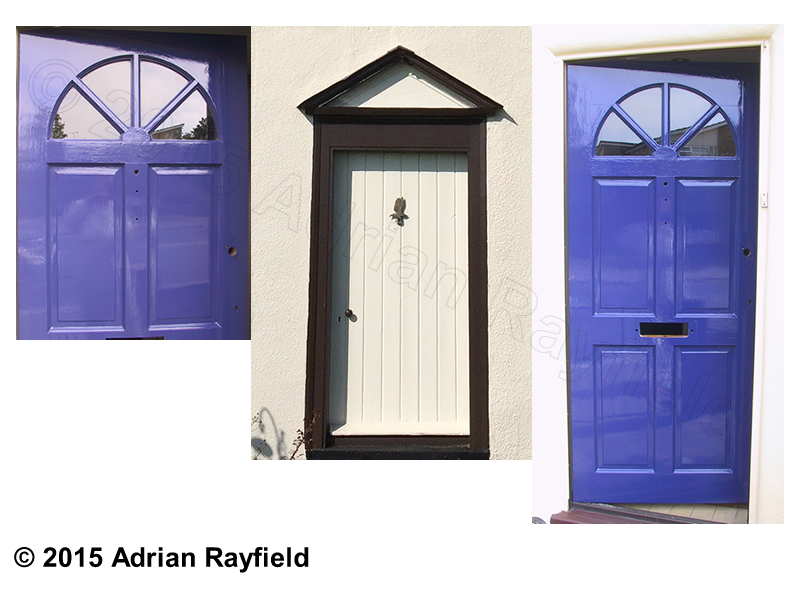Painting, decorating and home improvement tips blog
Wallpapering ‘Frames’
Posted by Adrian
June 29th, 2015
Wallpapering ‘Frames’
I have recently just completed a wallpapering job for a client. The room was a spare bedroom / playroom. As this room is to serve as a dual purpose room the client didn’t want the room to be too child like, or to grown up. The client looked online and decided on a wallpaper from Graham and Brown called Frames.
This wallpaper was ideal for the situation it was to be used in, modern and contemporary enough for any adults staying in the room, but also fun for a child. The frames on the paper can be used to stick family photos, postcards, artwork and you can even draw your own artwork directly into a frame to give it a totally unique style. If you do draw directly onto the wallpaper be aware that the paper is only spongeable and anything drawn onto the wallpaper may not come off.
About the wallpaper
The wallpaper is a paste the paper type, as opposed to paste the wall. The soaking time is around 5 minutes. The design / pattern match is free, so no matching up to do. The paper is 52cm wide and the rolls are 10 m long.
I found the paper easy to hang and the final result was very effective as you can see by the following photos.


Tags: bedroom, Frames, Playroom, Wallpaper, Wallpapering
Posted in Decorating Tips, News | 3 Comments »
How to paint a front door
Posted by Adrian
May 18th, 2015

How to paint a front door
From time to time you will need to paint your front door, if it is wood that is. Ideally pick a couple of dry days to complete the job such as spring or summer. Pick a good quality exterior paint to ensure a long lasting job.
The front door is one of the most seen parts of your house, a good looking door gives a good impression to visitors, and especially if you are selling your house as it gives kerb appeal.
You should gather all the tools required before starting, you will need:
- Screwdrivers
- Adjustable spanner
- Sandpaper (various grades)
- Primer
- Undercoat
- Topcoat (Satin or gloss)
- Paint stripper (optional)
- Heat gun (optional)
- Scraper (optional)
Ironwork / Door furniture
The first job is to remove all ironwork or door furniture such as locks, knocker, letterbox, escutcheon, door pull and numbers. This will make it far easier for working on the door. Put everything to one side being careful not to lose any screws as some can be tiny and you will need them again later to refit the ironwork / door furniture. You may need an adjustable spanner for the knocker or letterbox.
Preparation
As with all decorating jobs, preparation is key and will take most of your time. Now is the time to decide if you are simply going to re-decorate your door, or give it a real overhaul and strip the existing finish off back to bare wood.
If you are going to remove all the existing paint finish you can do this either by using a heat gun and scraper, or paint remover and scraper. The choice is really up to you. Once the door is stripped give it a good rub down and fill any crack and holes and sand these level and smooth. Once you have done this you are now ready to move to the next section, prime.
If you decide against stripping the door back to bare wood, or it simply doesn’t need it you should give the existing surface a good clean off to remove dirt and grime with a cloth and maybe water, the give the surface a good rub down. Fill any cracks or unwanted holes and rub them down level and smooth. Dust off and you can move onto the next section, prime.
Prime
Once you have prepared the door you should prime the entire door if you have stripped it back to bare wood, or spot prime bare wood if you have just rubbed down and filled. Allow to dry before moving onto undercoating.
Undercoat
Once you have primed the door, whether it be the entire door or spot primed, give the primer a light sand down before applying one or two coats of undercoat. Allow each coat to dry fully if you give it more than one coat sand back between coats for that perfect smooth finish.
Topcoat
Once you have prepared the door correctly and given it it’s necessary coats of primer and undercoat you can now give the door it’s final sand back and the final coat, the topcoat. This maybe a satin finish or a gloss. Again you may want to give two topcoats, but read the manufacturer’s instructions to ensure you leave enough time between coats, and a word of warning, if you sandback, you a fine paper and use light strokes. If you are too harsh you could scratch the surface too much, or even worse roll up the first coat and ruin all your hard work.
Non-painted or varnished doors
This post deals with painted doors, such a glossed doors but for other finishes, such as varnish or stained door the principle is the same, apart from you wouldn’t use primer or undercoat, however the preparation part is still applicable and needs to be done.

Tags: Door, Door Furniture, Filler, Filling, Gloss, Ironwork, Knocker, Letterbox, Lock, Paint, Painting, Preparation, Primer, Satin, Topcoat, Undercoat, Varnish, Woodstain
Posted in Decorating Tips | 1 Comment »
How to mix wallpaper paste video
Posted by Adrian
April 1st, 2015
How to mix wallpaper paste video
I have written a post previously about how to mix wallpaper paste, many people have problems getting it just right and get lumps in it or make it to thick or runny, not too dissimilar to porridge or custard!!. I decided to make a video showing you how to mix the perfect wallpaper paste, I have done it this way for years and mix the perfect paste every time.
I decided to make a video of myself mixing the paste on a recent job I did, the paste mixed was used to hang lining paper.
So here is the video…..
How to mix wallpaper paste video
I hope you find this video as well as our other videos helpful and informative, look out for more in the future.
Tags: How to mix wallpaper adhesive, Video, Wallpaper, Wallpaper adhesive
Posted in News, Video | No Comments »
